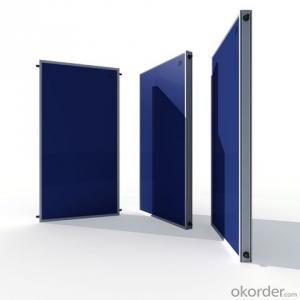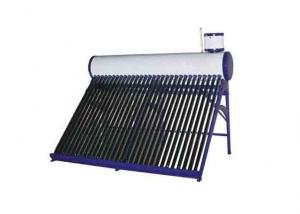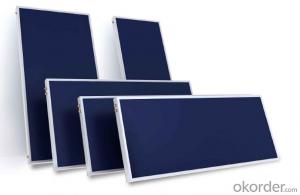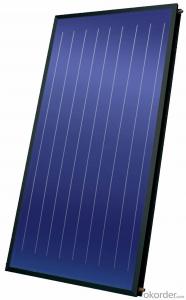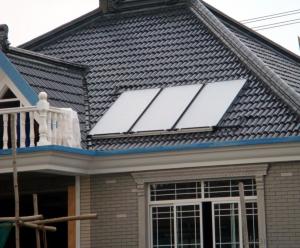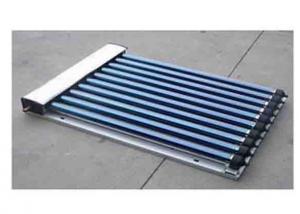Solar Water Heater
- Loading Port:
- China Main Port
- Payment Terms:
- TT or LC
- Min Order Qty:
- 5 Sets pc
- Supply Capability:
- 60,000 Sets per Year pc/month
OKorder Service Pledge
OKorder Financial Service
You Might Also Like
solar energy water heater,solar heating system,vacuum tube solar water heater:for household,school,enterprise,government,swimmin
Specifications:
1) Tank
a) Outer Tank material: galvanized armor plate.
b) Inner Tank material: imported SUS304-2B food grade stainless steel.
c) Water Tank Diameter: Φ410/420/460/470/480/500/520mm.
d) Insulating layer: 55-60mm polyurethane foame.
e) Tank Capacity: 90/110/150/180/200/210/240/300/350L.
2) Vacuum tube
a) Dimension: Φ47*1500mm/Φ58*1800mm.
b) Material: high boron silicon 3.3 glass.
c) Qty: 16/18/20/24/30/36 pcs.
d) Hail resistance diameter: Φ25mm
e) Tube coating: by AL-N-AL or ALN/AIN-SS/CU.
3) Bracket
a) Material: color armor plate.
b) Thickness: 1.5mm.
c) Obliquity: from 38o to 45o .
4) Certificates: ISO9001:2000,CCC,CE
- Q:Can solar collectors be used for heating car service centers?
- Yes, solar collectors can be used for heating car service centers. Solar thermal collectors can convert sunlight into heat energy, which can be utilized for various heating applications, including heating the interior space of car service centers. This can help reduce reliance on traditional heating systems and decrease energy costs while promoting environmentally friendly practices.
- Q:What is the best orientation for solar collectors?
- The best orientation for solar collectors is typically facing south, as this allows them to receive the maximum amount of sunlight throughout the day. However, the optimal orientation may vary depending on the specific location and desired performance of the collectors.
- Q:Are solar collectors easy to install?
- Yes, solar collectors are relatively easy to install. They require basic tools and can be installed on rooftops or in open spaces. However, professional installation is recommended to ensure optimal positioning and performance.
- Q:What is the impact of wind on the performance of solar collectors?
- The performance of solar collectors can be affected positively or negatively by wind. One advantage is that wind can prevent overheating by cooling the solar collectors. This is especially useful in hot climates where excessive heat can reduce the efficiency of the solar panels. The movement of air caused by wind can dissipate heat and maintain optimal operating temperatures, leading to improved performance and longevity of the solar collectors. On the flip side, strong winds can have a detrimental effect on solar collectors. If the wind speed exceeds a certain limit, it can cause damage to the solar panels or their support structures. This damage can result in loss of functionality and decreased efficiency of the solar collectors. Furthermore, high winds can create turbulence and eddies, disrupting the airflow around the solar collectors. This turbulence can cause uneven distribution of airflow and reduced heat transfer, leading to decreased energy production. Therefore, it is important to consider the potential risks associated with high wind speeds, despite the benefits of wind in cooling the solar collectors. Proper installation and design considerations, such as wind-resistant mounting systems and aerodynamic design features, can help mitigate these negative impacts and ensure optimal performance of solar collectors even in windy conditions.
- Q:Are solar collectors suitable for residential communities?
- Yes, solar collectors are highly suitable for residential communities. They offer numerous benefits that make them an ideal energy solution for homeowners in residential areas. Firstly, solar collectors help reduce electricity bills significantly. By harnessing the sun's energy, homeowners can generate their own electricity, reducing their reliance on the grid. This not only saves money but also helps mitigate the impact of rising energy costs. Secondly, solar collectors are environmentally friendly. They produce clean and renewable energy, which reduces greenhouse gas emissions and helps combat climate change. By installing solar collectors in residential communities, we can contribute to a greener and more sustainable future. Moreover, solar collectors require minimal maintenance. Once installed, they operate silently and do not produce any harmful emissions. This makes them highly convenient for homeowners, as they do not need to worry about ongoing maintenance or additional costs. Additionally, solar collectors increase the value of residential properties. Studies have shown that homes equipped with solar panels or collectors have higher resale values compared to those without. As more people become environmentally conscious, the demand for solar-powered homes is increasing, making them a wise investment for residential communities. Furthermore, solar collectors offer energy independence. They allow homeowners to generate their own power, reducing their dependence on the grid and providing a reliable source of electricity. This is particularly advantageous during power outages or emergencies, as solar panels can continue to produce electricity as long as the sun is shining. In conclusion, solar collectors are highly suitable for residential communities. They offer significant financial savings, environmental benefits, low maintenance requirements, increased property value, and energy independence. By embracing solar energy, residential communities can contribute to a more sustainable future while enjoying the numerous advantages that solar collectors provide.
- Q:What is the maintenance cost of a solar collector?
- The maintenance cost of a solar collector varies depending on factors such as the type of collector, size, location, and overall condition. However, in general, the maintenance cost of a solar collector is relatively low. Routine maintenance tasks may include cleaning the surface of the collector, checking for any leaks or damages, inspecting and cleaning the pipes or tubes, and ensuring proper functioning of the system. These tasks can typically be performed by the homeowner or a professional solar technician. Overall, the maintenance cost of a solar collector is considered to be minimal compared to the long-term energy and cost savings it provides.
- Q:Can solar collectors be used for heating commercial buildings in winter?
- Yes, solar collectors can be used for heating commercial buildings in winter. Solar thermal systems can collect and convert solar energy into heat, which can then be used for space heating in commercial buildings. These systems typically use solar collectors to capture the sun's heat and transfer it to a fluid, which is then circulated to provide heating throughout the building. While solar thermal systems may not provide all of the heating needs for a commercial building during winter, they can significantly reduce reliance on traditional heating sources and contribute to energy savings.
- Q:How long does it take for solar collectors to pay for themselves?
- The time it takes for solar collectors to pay for themselves, also known as the payback period, varies depending on several factors. These factors include the initial cost of the solar collectors, the amount of energy they can generate, the cost of alternative energy sources, and any available financial incentives or tax credits. On average, solar collectors have a payback period of around 10 to 20 years. However, this can be shorter or longer depending on the specific circumstances. In regions with high electricity costs or ample sunlight, the payback period can be shorter, typically around 5 to 10 years. In contrast, areas with lower electricity rates or less favorable solar conditions may have longer payback periods, often exceeding 20 years. It's essential to consider the long-term benefits of solar collectors beyond the payback period. Once the initial investment is recouped, solar collectors can continue generating electricity for many more years, offsetting or even eliminating utility bills. This can result in significant savings over the system's lifetime. Moreover, solar collectors contribute to reducing carbon emissions and promoting sustainability. They provide clean energy, help combat climate change, and reduce dependence on fossil fuels. Considering these environmental benefits, the payback period becomes just one aspect of the overall value of solar collectors. To accurately determine the payback period for solar collectors in a specific situation, it is advisable to consult with solar professionals or financial advisors who can assess the local conditions, energy consumption, and available incentives. They can provide a more precise estimate based on the specific factors at play.
- Q:Can solar collectors be used for generating electricity on electric vehicle charging stations?
- Solar collectors, like solar panels, have the ability to generate electricity at electric vehicle charging stations. These stations can be equipped with solar collectors either on their roofs or nearby to capture solar energy and transform it into usable electricity. Consequently, this electricity can be utilized to operate the charging stations and charge electric vehicles. This approach not only offers a renewable and eco-friendly energy source but also reduces dependence on the conventional power grid. Moreover, solar collectors can be combined with energy storage systems to store surplus solar energy, guaranteeing a consistent and dependable power source for electric vehicle charging stations.
- Q:Can solar collectors be used for heating vineyards?
- Yes, solar collectors can be used for heating vineyards. Solar collectors can help provide a sustainable and renewable source of heat for vineyards, reducing reliance on fossil fuels and lowering greenhouse gas emissions. This technology can be particularly useful in cooler climates where additional heating is needed to protect vineyards from frost and cold temperatures.
1. Manufacturer Overview |
|
|---|---|
| Location | Zhejiang,China |
| Year Established | 2005 |
| Annual Output Value | US$2.5 Million - US$5 Million |
| Main Markets | North America South America Eastern Europe Southeast Asia Africa Oceania Mid East Eastern Asia Western Europe Central America Northern Europe Southern Europe Domestic Market |
| Company Certifications | ISO9001:2008;ISO14001:2004 |
2. Manufacturer Certificates |
|
|---|---|
| a) Certification Name | |
| Range | |
| Reference | |
| Validity Period | |
3. Manufacturer Capability |
|
|---|---|
| a)Trade Capacity | |
| Nearest Port | Shanghai,Hangzhou |
| Export Percentage | 41% - 50% |
| No.of Employees in Trade Department | 6-10 People |
| Language Spoken: | English, Chinese |
| b)Factory Information | |
| Factory Size: | 5,000-10,000 square meters |
| No. of Production Lines | 5 |
| Contract Manufacturing | OEM Service Offered Design Service Offered Buyer Label Offered |
| Product Price Range | Average |
Send your message to us
Solar Water Heater
- Loading Port:
- China Main Port
- Payment Terms:
- TT or LC
- Min Order Qty:
- 5 Sets pc
- Supply Capability:
- 60,000 Sets per Year pc/month
OKorder Service Pledge
OKorder Financial Service
Similar products
New products
Hot products
Hot Searches
Related keywords







